by Deep Green Resistance News Service | Mar 10, 2016 | Biodiversity & Habitat Destruction, Movement Building & Support
By Wildlands Defense
Two months have gone by in a blur since the Bundy Militant Seizure of Malheur National Wildlife Refuge. The Refuge was taken under the cover of cowboy hats. Public lands ranchers have always been at the front of western land grab efforts, as Bernard DeVoto described.
Malheur brought unsavory players engaged in a medusa-headed effort to seize control of public lands into full public view. Proliferating militias, “constitutional sheriffs,” and various crackpot lecturers were suddenly out in public view, all on board with the land privatization agenda.
WLD’s Natalie Ertz and Kate Fite traveled to Malheur to join a Protest opposing the Bundy Seizure. We hiked on the Refuge, where Militants “on patrol” attempted to intimidate us. We met up with the Center for Biological Diversity folks who had been at Malheur for many days, and several other Boise people who came out for the event. (3rd video)
We had the privilege to speak with leaders of the Burns-Paiute Tribe. We witnessed a surreal Militant ceremony where New Mexico rancher Adrian Sewell renounced his grazing permit. At the end of this, Pete Santilli tried to incite an armed crowd against an environmentalist by claiming he was an FBI agent.
Just as we returned home, we learned of a Land Seizure Conference in Boise only a few days away – “Storm Over Rangelands”, with Kanosh Utah attorney Todd MacFarlane, a member of the militia-like Harney County Committee of Safety, and others.
We worked to organize a Protest march, and documented the
conference, which preached there is no such thing as public land – grazing on BLM land establishes a “right” for the cattlemen, so the land is no longer public.
Members of the Bundy Cowliphate have now been arrested. But the Land Seizure movement remains in high gear. The fight to protect public lands is now more important than ever. At least three Bills have been introduced in the Congress to give states control of federal lands.

Cottonwood creek – Owyhee Field Office, Idaho BLM. Monitoring cage illustrates typical degree of forage removed by livestock that would otherwise stabilize stream-banks, purify water, and be available to wildlife. (Photo: Brian Ertz)
There are myriad other efforts chipping away at public lands and public lands protections in Congress and state Legislatures across the West.
This is a very important time in the fight to protect wild lands and wildlife in the west. Please support our frontline efforts to protect public lands.
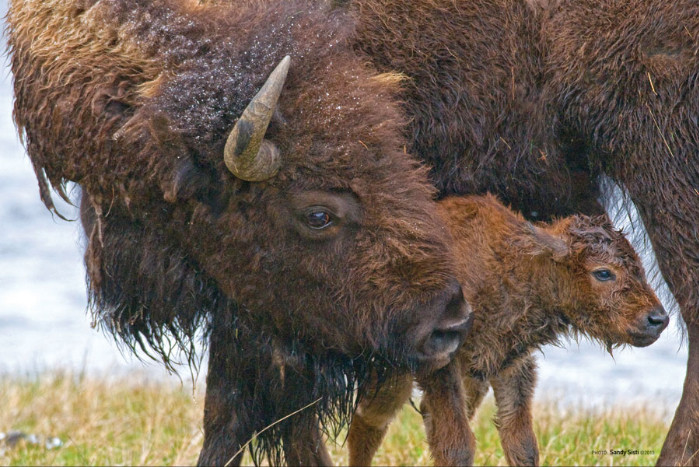
by Deep Green Resistance News Service | Mar 7, 2016 | Biodiversity & Habitat Destruction
By Buffalo Field Campaign
SPECIAL ALERT: Phone Calls Needed Today to Stop Imminent Buffalo Slaughter
Yellowstone National Park is holding approximately 150 of America’s last wild buffalo captive in their Stephens Creek bison trap. The Park Service intends to ship these gentle giants to slaughter facilities beginning this week! Why does Yellowstone slaughter America’s last wild buffalo? Because Montana’s livestock industry pressures them to. There is no justification for it, no matter what the Park Service tells you. Wild bison are not overpopulated, and the so-called brucellosis threat is a livestock industry excuse to kill wild buffalo and prevent them from reinhabiting their native landscape.
So many of you have been taking action, calling Yellowstone National Park, and urging them to set these buffalo free. Thank you so much! Unfortunately, Yellowstone has been unresponsive. Yellowstone’s superintendent still needs to hear from you, but we need to increase our pressure and take our message all the way up to the White House. We also need to contact Montana Governor Steve Bullock and tell him to end livestock industry authority over wild, migratory bison, which is the driving force behind Yellowstone’s participation in the slaughter of America’s last wild buffalo.
PLEASE TAKE ACTION TODAY!
* CALL PRESIDENT OBAMA AT THE WHITE HOUSE: #202-456-1111
Tell President Obama to make Yellowstone stop the buffalo slaughter and set the captive buffalo free! There is no justification for killing members of the world’s most important bison population, beloved the world over. Tell the President you do not want your hard-earned tax dollars to be spent on destroying a natural, national treasure.
* CALL MONTANA GOVERNOR STEVE BULLOCK: #406-444-3111
Tell him you stand with the majority of Montanans who want wild, migratory bison restored in this state. Tell him bison slaughter hurts tourism, and insist that he work to end livestock industry policies and intolerance, which are the driving force behind Yellowstone’s participation in the slaughter of America’s last wild buffalo.
* CALL YELLOWSTONE’S SUPERINTENDENT DAN WENK: #307-344-2002
Demand that he cease catering to livestock industry intolerance, release the captured buffalo, and end plans to slaughter! His willing participation in slaughtering America’s last wild buffalo goes against the National Park Service’s mission and Yellowstone’s own bison science!
Thank you so much for taking these actions for the country’s last wild buffalo!

by Deep Green Resistance News Service | Feb 18, 2016 | Biodiversity & Habitat Destruction
By Deep Green Resistance
Wild Bison are an icon of what has been destroyed by civilization, and this species is now on the brink in the wild. Almost all bison left today are cross-breeds held in confinement. There are only a few wild, free ranging bison herds left on the planet, and their numbers are small. Every year, the Park Service — at the behest of ranchers — round up, quarantine, harass, and kill many of the wild bison who live in and around Yellowstone National Park. We stand with grassroots land defenders such as the Buffalo Field Campaign in calling for an immediate end to this atrocious treatment of wild bison. Instead of quarantine, these creatures need room to roam. Instead of harassment, they need our assistance in growing once again to their historical numbers.

From Buffalo Field Campaign:
Yellowstone National Park has released an Environmental Assessment (EA) for a fifty-year quarantine program which seriously threatens America’s last wild, migratory bison population. Unfortunately there is very little in this EA for bison advocates to support, as even the “no action” alternative maintains the Park’s ongoing capture-for-slaughter program. Comments are due by midnight MDT February 29, 2016. (This is a new, extended deadline.)
Quarantine domesticates wild bison, subjects them to artificial selection and commercial management practices and treats them like livestock. Quarantine is an insult to First Nations buffalo cultures with strong cultural, spiritual, and traditional ties to wild, migratory buffalo in and around Yellowstone. Quarantining wild, migratory bison and dooming them to a life behind fences ignores the critical keystone relationship between wild bison and their natural prairie and grassland communities. Migration is one of the buffalo’s strongest, most significant gifts to a healthy landscape. Quarantine reduces buffalo to a domesticated state, and is not appropriate for wildlife. Quarantine, which imposes a state of control and surveillance over wild bison, is the direct result of the livestock industry’s intolerance. Quarantine is a toxic mimic of natural restoration, a program in which humans manipulate the wild and free to suit their own selfish agendas. Quarantine does not end slaughter, it begins with it, ripping buffalo families apart and orphaning calves who spend the rest of their lives behind fences.
Yellowstone’s ongoing capture-for-slaughter and fifty-year quarantine plan will result in extremely adverse cumulative impacts, and we need to force the agency to seriously and honestly review the best available scientific information in a comprehensive Environmental Impact Statement (EIS).
Recent history has already shown that quarantine does not work for wild bison. The Quarantine Feasibility Study that began in 2005 resulted in wild Yellowstone buffalo being commercially owned for profit, while some of the buffalo who went to Ft. Peck died in a horrible fire because they could not escape their enclosure, and half of the herd that was transferred to Ft. Belknap died because they could not escape their enclosure to find fresh water. Wild bison do not belong behind fences, they are a nation unto themselves who evolved to migrate, wild and free!
TAKE ACTION! Please use the sample letter below only as an example, and in your own words, address the adverse impacts of quarantining wild bison and the Park’s ongoing capture for slaughter mismanagement scheme. Don’t allow Yellowstone National Park to domesticate wild, migratory bison!
HOW TO SEND YOUR COMMENTS: Respondents are encouraged to submit their comments online through the Planning, Environment and Public Comment (PEPC) website at www.parkplanning.nps.gov/BisonQuarantine. Comments may also be hand-delivered to the park administration building, or mailed to: Superintendent, Yellowstone National Park, Wyoming, 82190. Comments will NOT be accepted by fax, e-mail, or in any manner other than those specified above.
SAMPLE LETTER – Please edit with your own remarks! See above for instructions on how to submit your comments. Due by February 29, 2016.
Superintendent Dan Wenk
Yellowstone National Park
Attn: Bison Quarantine EA
P.O. Box 168
Yellowstone National Park, Wyoming 82190
RE: Comments on Yellowstone Bison Quarantine Program EA
Dear Superintendent Wenk,
Thank you for the opportunity to comment on Yellowstone’s quarantine environmental assessment (EA). I am strongly opposed to Yellowstone’s proposed fifty-year quarantine plan as well as the Park’s ongoing capture-for slaughter operations. As an advocate for wild, migratory bison, I find it impossible to support quarantine in Yellowstone or elsewhere, or your no-action alternative to continue capturing wild buffalo for slaughter.
Yellowstone’s proposed fifty-year quarantine plan, as well as the Park’s ongoing capture-for-slaughter operations have significant cumulative negative impacts, which requires your agency to seriously and thoroughly review the best available information in a comprehensive Environmental Impact Statement.
The U.S. Congress never intended for wild buffalo in Yellowstone to be declared “surplus” and did not authorize the Secretary of the Interior to remove wild buffalo as “surplus” for quarantine. By regulation, Yellowstone National Park is prohibited from removing “surplus” wild buffalo from the population in Yellowstone “when the animals are to be slaughtered, or are to be released without adequate protection from premature hunting.” 36 C.F.R. § 10.3(d) (2015).
Yellowstone’s fifty-year quarantine program is in direct violation of the Organic Act and National Park Service policies, as it includes capturing wild bison for quarantine with potential recipients including agricultural or commercial producers, reducing ecologically extinct wild bison to livestock.
Wild bison are further adversely impacted by Yellowstone’s proposed quarantine plan and ongoing capture-for-slaughter operations, which aim to reduce America’s last continuously wild herds to a mere 3,000 animals, and maintain this low population, making wild bison extremely vulnerable by threatening their natural immunity to introduced diseases from cattle and elsewhere, including brucellosis. Such poor management practices increase the risk of wild bison becoming more vulnerable to various diseases as strains become more virulent and persistent. Further, the population target of 3,000 is based on livestock industry politics and lacks scientific or ecological basis.
In recent history, Yellowstone’s participation in the state-federal Quarantine Feasibility Study resulted in the commercialization and privatization of wild bison, making a commodity of our nation’s valued wildlife. It resulted in the domestication of wild bison originating from Yellowstone. All of the wild bison who survived the quarantine feasibility study have been reduced to private livestock or meat behind fences, many of which died throughout the process, through transport to other quarantine facilities, or who suffered horrible deaths by fire and dehydration as a result of their confinement.
The recent quarantine program has been a failure. There is no indication that quarantine with the costly, restrictive, and burdensome requirements of the U.S. Department of Agriculture will in any way lead to the recovery of ecologically extinct wild bison as a wildlife species anywhere in the country. Quarantine domesticates. It harms and degrades the wild integrity of America’s last wild bison population and subjects wild bison to commercial management practices and artificial selection.
Indigenous people of North America have held strong cultural and spiritual ties to wild, migratory buffalo for tens of millennia. Some of these relationships are so deep that the people consider the buffalo to be actual relatives. “Offering” indigenous buffalo cultures the return of their relatives through quarantine and capture-for-slaughter can be viewed as a continuation of the U.S. government’s assimilation program, which aims to make cattle out of wild, migratory bison, and livestock producers out of traditionally nomadic indigenous buffalo cultures.
Ongoing capture-for-slaughter operations and the proposed quarantine program are a violation of the treaty rights held by more than twenty-five sovereign, indigenous nations. The harmful programs of hazing, quarantine, and slaughter prevent wild, migratory bison from restoring themselves on their native landscape, including open and unclaimed public lands. These nation-to-nation treaties, which the federal government has a legal obligation to honor, hold that these indigenous cultures have a sovereign right to hunt, gather, and hold ceremony on open and unclaimed lands. Sadly, wild, migratory bison are absent and unavailable on many of these lands due to these bison management practices.
Yellowstone’s fifty-year quarantine plan further harms wild, migratory bison because quarantine has adverse impacts on herd dynamics, social structure, and collective wisdom handed down through generations. Quarantine negatively modifies wild bison behavior in ways that are unnatural and harmful, including continuing pressures of domestication, conditioning to human manipulation, and artificial selection — all tools for managing livestock, not wildlife. Wild, migratory bison are able to take care of themselves, with no cost or need of interference from humans. Wild bison are able to create and manage their own habitat, while bison behind fences invoke restrictive, costly, and burdensome requirements by the U.S. Department of Agriculture.
Yellowstone National Park’s voluntary agreement to adhere to the highly controversial Interagency Bison Management Plan contradicts the mission of the National Park Service. The Park Service and other IBMP member agencies fail to operate using the best available science and information, falling back instead on expired information and misguided assumptions, in direct violation of the Park Service’s mandate.
Nearly 6,000 ecologically extinct, wild, migratory bison have been killed or eliminated from America’s last continuously wild population with direct and indirect participation from Yellowstone National Park, through capture-for-slaughter, quarantine, hazing fatalities, and the surrender of wild bison for scientific experiment. An independent population viability analysis must be conducted (and funded) by Yellowstone National Park to determine how management actions and consequent cumulative impacts threaten the long-term viability, diversity, integrity, and evolutionary potential of wild, migratory bison. It is also required that an impairment review be undertaken to determine the long-term and cumulative impacts of capture-for-slaughter operations and the proposed fifty-year quarantine program.
There is a win-win situation for wild, migratory bison and indigenous buffalo cultures that does not include the mass killing or domestication of wild bison: natural restoration through the simple and ancient natural phenomenon of migration. Migration corridors must be protected and made available to wild bison by federal, state, and public trust land management agencies, working with private landowners and tribal governments. The migration corridors in and around Yellowstone are a first priority, along with the protection of the bison themselves — both of which are denied under current management. When wild bison are protected and allowed to restore themselves throughout their native range, they will naturally return to the lands that are their birthright, lands they have been forcibly and lethally removed from, where indigenous buffalo cultures are ready to welcome them home.
Sincerely,
[Your name]
Read more at Buffalo Field Campaign. Help support BFC here.
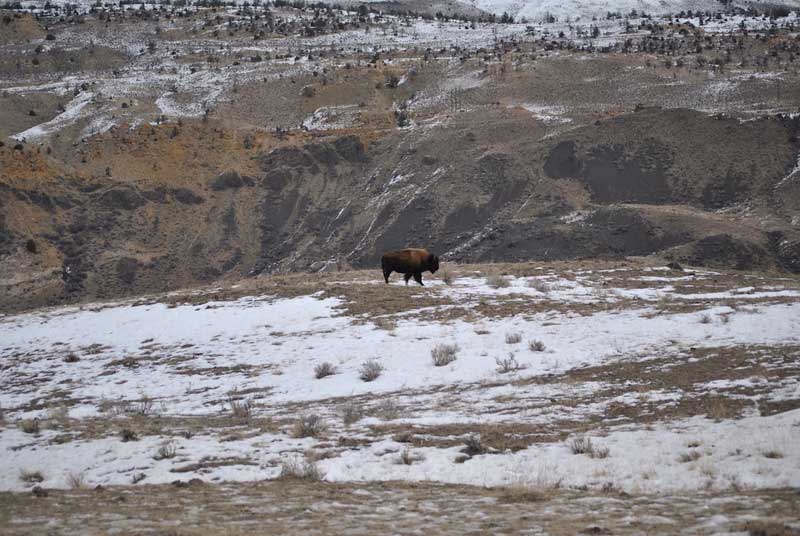
by Deep Green Resistance News Service | Jan 22, 2016 | Biodiversity & Habitat Destruction
By Stephany Seay / Buffalo Field Campaign
Featured image: A young bull buffalo walks the hills in the Gardiner Basin. Photo by Stephany Seay
Based on what we witness in the field everyday, the killing taking place near Gardiner could more accurately be described as a slaughter than a hunt. The tribal game wardens we have spoken with agree, and they recognize that Montana’s livestock interests have organized the circumstances to shift blame away from themselves to the tribes. There is obviously something terribly wrong when every last buffalo to migrate through Beattie Gulch ends up dead, or when hunters feel so desperate to kill every buffalo they see. Whether or not tribal hunters view their hunts as supporting the larger management scheme, the Interagency Bison Management Plan (IBMP) government agencies and affiliated tribal entities certainly do. There is no moral or scientific justification to the idea, perpetuated by the management agencies, of “surplus buffalo” and safeguards allowing buffalo safe passage between Yellowstone and Montana are sorely needed.
We have never and will never stand against treaty rights, but we maintain a steadfast opposition to the current management that uses hunting as a means to eradicate the buffalo. As currently practiced, the hunt is an extermination plan set up by livestock interests to ensure that buffalo never reclaim the lands that are their ancestral home and birthright. It is fundamentally wrong and immoral for hunters to be led to believe that if they don’t kill the buffalo in this way, that they will just be slaughtered anyway.

This little buffalo calf was shot in the leg by hunters at Beattie Gulch. He survived and somehow managed to run off, escaping through nearby private land; but his leg was shattered. A Montana game warden shot him to end his suffering, then with assistance from a Montana Department of Livestock stock inspector and U.S. Forest Service law enforcement officer, he was hauled out from his resting place along the Yellowstone river. As if to reward this unethical hunting behavior, the agents ended up giving him to the hunter who wounded him. Photos by Stephany Seay (above) and Deleana Baker (below), Buffalo Field Campaign.

So long as buffalo die, the livestock industry and the governments don’t care who does the killing or how. Contrast this to the tens of thousands of elk in the region who have been implicated in the transmission of brucellosis, and yet no one is claiming that there are “surplus” elk and no one is targeting them for transmitting disease to cattle. The welfare ranchers don’t want to lose their foothold on control of the grass, so the buffalo, whom they view as competitors, must die. Hunters are in fact serving livestock interests no matter an individual hunter’s intentions.
The buffalo death toll is quickly rising. More than fifty of the country’s last wild buffalo have been killed by hunters since we last wrote. Mid-week, over five-hundred buffalo migrated into Montana, nearly all at once, through Beattie Gulch at Yellowstone’s north boundary. Being in the midst of this ancient phenomenon is at once one of the most beautiful and most heartbreaking experiences. The migration of hundreds of buffalo is such a beautiful sight, a flow that has purpose and integrity, so simple in its power, timeless and perfect, seemingly unstoppable; but this ancient march is also heartbreaking because it leads so many buffalo straight to their deaths.
As we expected, word of this migration spread quickly, and hunters arrived en masse that night, the following day, and through the weekend. We expected a massacre, but through the course of days, the majority of the buffalo threatened to cross various lines, edging towards areas where they could be hunted, only to retreat in the nick of time. Frustrated hunters were driving all over the Basin, even through the Park, following us, glaring at us, wanting to blame us, looking for buffalo that they could kill, but finding few. Those few were gunned down rapidly at the Park boundary, in acts of haste and desperation. Many have been shot and wounded, fleeing into Yellowstone where hunters cannot pursue them, left to die slowly or walk forever with bullets in their flesh.
By Sunday, frustrated and determined to get their buffalo meat, hunters in pick-ups and on foot crowded around the park boundary, watching a family group of about thirty buffalo slowly make their way towards Beattie Gulch. The firefight that ensued that morning ended life for twenty-eight of those buffalo; the eight survivors, two of them shot and wounded, fled up the mountain and away with their lives.
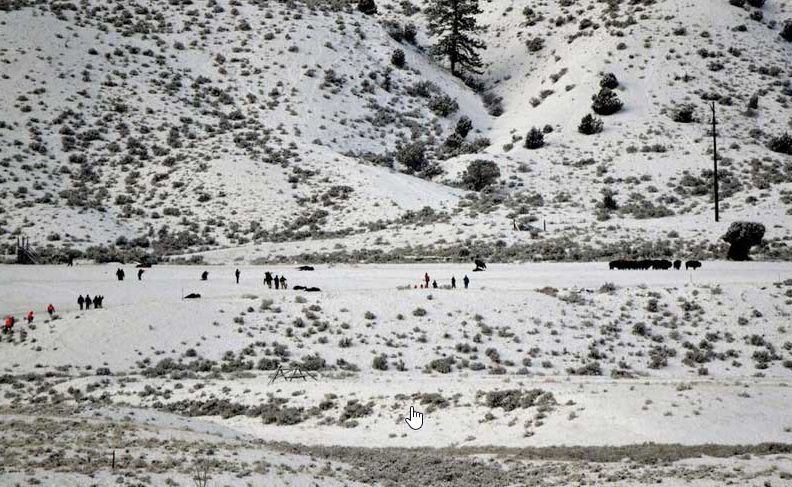
Images from the slaughter at Beattie Gulch, described above. Photos by Deleana Baker, Buffalo Field Campaign.
Make no mistake: BFC fully supports treaty rights and tribal sovereignty, yet our first priority is to the buffalo. What is taking place here is an extermination plan, and hunters are being used. We have to work in solidarity to demonstrate this, to end livestock control, and to get the buffalo — through migration — back on the landscape, in great numbers so that the proper, respectful relationships can be restored. Buffalo will take care of the people, but the people need to take care of them first. They need our help.
This whole Plan — which treaty hunting is certainly a part of from the government’s viewpoint, and all the discussions and decisions that happen within the IBMP — is in place to harm the buffalo and to keep them from restoring themselves across the landscape. We need to put our collective energy into fighting the IBMP and the law that places the Montana Department of Livestock in charge of buffalo in Montana. We must acknowledge that wild buffalo are ecologically extinct, and the IBMP is using hunting as well as slaughter and hazing to facilitate their destruction, to prevent their restoration.
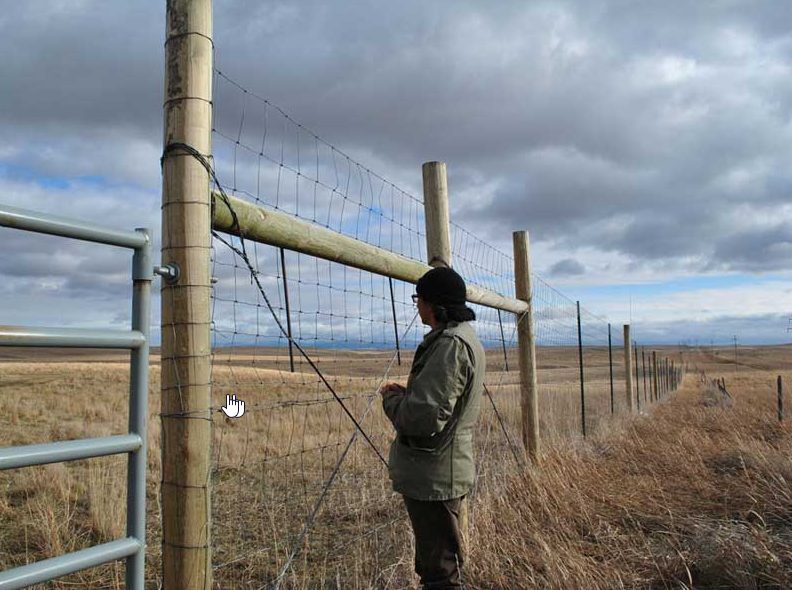
Catcher Cuts the Rope, Gros Ventre (A’aninin), looks into the formidable enclosure where quarantined Yellowstone buffalo now reside on the Ft. Belknap Indian Reservation. Photo by Stephany Seay, Buffalo Field Campaign.
The same can be said of quarantine, which is a management tool for livestock, not wildlife. Again, livestock interests present “choices”: dead buffalo or buffalo behind fences. Yellowstone National Park is aiming to develop a fifty-year plan for operational quarantine, making the process of domesticating wild, migratory buffalo an entrenched aspect of bison management. To be free or caged in is not an option in the wild world, it is a human option. Quarantine is something to satisfy the human; an easy way out, a toxic mimic of true wildlife restoration. It is a means to control what should be free. Quarantine is also part of the brucellosis lie, the premise being that bison pose a brucellosis threat, which we know to be untrue. Should elk be quarantined also? Elk have brucellosis but roam free.
The quarantine process begins with buffalo families being torn apart, adults shipped to slaughter, calves orphaned and raised in domestication. Then, those who survive the human-handling and testing of the quarantine process will live behind fences for the rest of their lives. We have seen the buffalo who suffered “living” in quarantine; they were not happy, they looked to get out of those pens. They were humiliated and afraid. Many of them have died horrible deaths because they could not escape their enclosures. Quarantine is part of the culture of death, this “civilized” system that systematically destroys life on the planet. Quarantine asks us to accept an “easy fix” that will give the human ego gratification.
Migration is free and alive; it is having the ability to make choices, being self-willed. Buffalo behind fences to be food for humans is a view that reduces them to meat. They have strong relationships with more than humans. The compromise should be in standing aside and respecting how a creature places one foot in front of the other — and we fight those things that get in the way of that. Quarantine removes the buffalo from their natural community, from life and their gift to life. Who is asking the buffalo’s perspective, asking them what they want? The buffalo will tell you that migration is they key to restoration. They know the way.
So many feel stuck in the “choices” that the government and industry have put before us. People believe that they are doing the buffalo a “favor” by hunting them, or by supporting quarantine, because otherwise they would be captured and shipped to slaughter. They are shipped to slaughter anyway. Having to pick hunt, quarantine, or slaughter is being forced to make artificial and unnecessary choices. So long as this Plan is in place, so long as Montana is in control, so long as wild buffalo numbers are driven down to serve livestock industry politics, and so long as wild buffalo are prevented from restoring themselves on the landscape, the problems will persist. We must fight this Plan and livestock control in all it’s guises. We must demand an end to livestock control, demand that wild buffalo walk the earth, demand an end to this management scheme.
One industry’s intolerance is driving a national treasure towards the brink of extinction. We must put an end to livestock industry control over wild buffalo, and to do so we must repeal the law — MCA 81-2-120 — that places them in charge. As evidenced by his decision to grant year-round habitat on Horse Butte, Montana Governor Steve Bullock is listening, but the livestock industry is trying to undermine his citizen-supported decision. He must hear from us all, frequently. Please contact Governor Bullock today, even if you have already, thank him for granting year-round habitat on Horse Butte and urge him to help repeal MCA 81-2-120. With endless pressure, endlessly applied, we can end livestock industry control and gain more of the buffalo’s Montana home for them to roam.
Thank you so very much for being with us for wild buffalo!
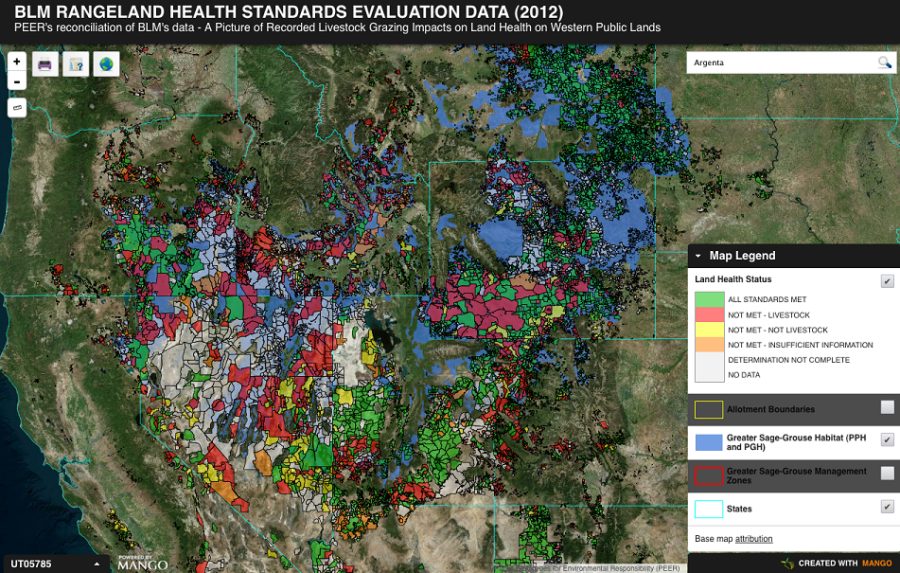
by Deep Green Resistance News Service | Jan 19, 2016 | Biodiversity & Habitat Destruction
Searchable BLM reports and satellite images for 20,000 grazing allotments
Featured image: The map includes blue-tinted areas that represent Greater sage grouse habitat, underneath the tens of thousands of tinted grazing allotments. Image by High Country News.
When the Bureau of Land Management ordered the removal of cattle from public rangeland this summer near Battle Mountain, Nevada, the state was in its third year of severe drought. Conditions were too dry to sustain the number of cattle that were grazing there, the BLM contended. Locals responded in part by announcing a “Cowboy Express” ride from Bodega Bay, California to Washington, DC to protest federal overreach and to demand that local District Manager Doug Furtado be ousted.
Disagreements like the one in Battle Mountain are hardly novel in Western politics. But this week, a new tool to understand livestock impact on public lands was thrown into the mix. Washington, DC-based non-profit Public Employees for Environmental Responsibility (PEER) released an interactive map that collates over 45,000 BLM records that diagnose 20,000 allotments. The map is seven years in the making, the result of Freedom of Information Act requests PEER and Western Watersheds Project put to the BLM.
Read more at A new map shows rangeland health West-wide

Damage to the land from livestock can be seen in satellite images. Image by High Country News.

Shaded areas indicate where rangeland has failed to meet BLM health standards between 1997 and 2013. Image by High Country News.












